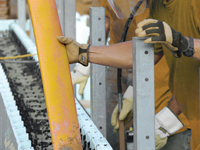 Building a house from the ground up gives the homeowner total quality control— and this is especially important for structural energy efficiency. Decision-making is a big job however, so you might want to start with a guideline from the non-profit organization Leadership in Energy and Environmental Design (LEED). By developing a rating system, the LEED for Homes division promotes high-performance houses that use energy efficient construction materials. For example, some of the highest rated homes and buildings use a concrete system, not wood, for building walls – and it’s a Canadian company, Nudura, that leads in this field. The system uses pre-assembled ICFs (insulated concrete forms) which, at the construction site, lock in together a little like Lego. Concrete has shown to deliver a stronger, safer, healthier, and a more cost efficient house, according to the company (nudura.com). Furthermore, LEED reminds us that a green home will: use less energy, water and natural resources; create less waste; and be healthier and more comfortable for the occupants. Industry specialists also say that this method has the capability of delivering up to 70 per cent energy savings as compared to traditional wood framing.
Building a house from the ground up gives the homeowner total quality control— and this is especially important for structural energy efficiency. Decision-making is a big job however, so you might want to start with a guideline from the non-profit organization Leadership in Energy and Environmental Design (LEED). By developing a rating system, the LEED for Homes division promotes high-performance houses that use energy efficient construction materials. For example, some of the highest rated homes and buildings use a concrete system, not wood, for building walls – and it’s a Canadian company, Nudura, that leads in this field. The system uses pre-assembled ICFs (insulated concrete forms) which, at the construction site, lock in together a little like Lego. Concrete has shown to deliver a stronger, safer, healthier, and a more cost efficient house, according to the company (nudura.com). Furthermore, LEED reminds us that a green home will: use less energy, water and natural resources; create less waste; and be healthier and more comfortable for the occupants. Industry specialists also say that this method has the capability of delivering up to 70 per cent energy savings as compared to traditional wood framing.
www.newscanada.com
Latest posts by Canadian Home Trends (see all)
- Layer Up – Wrap Your Bathroom In Light - December 21, 2025
- The Power of Rest: Elevate Your Wellness with Better Sleep - December 21, 2025
- VERSATILE KITCHEN DESIGN - December 21, 2025






